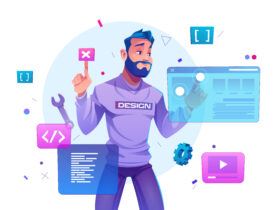Digital marketing has become highly competitive. Audiences scroll quickly, attention spans are short, and thousands of brands are fighting for visibility every day. In this environment words alone rarely make people stop and engage. Visual communication has become the deciding factor in whether your message is noticed, remembered, and acted upon. For small businesses that want to grow locally or online, learning how to use visual elements with intention can turn ordinary marketing into a powerful brand experience.
What visual communication means in digital marketing
Visual communication is the use of images, graphics, colors, layouts, videos, and other visual elements to deliver a message more effectively than text alone. When done well, visuals make information easier to process, more attractive to the eye, and more memorable to the mind. In digital marketing, visuals appear in every format: social media posts, website banners, product images, advertisements, infographics, and short form videos.
Unlike plain text, visuals trigger emotional responses quickly. A photograph of fresh food makes you feel hungry. A video of a happy customer makes you trust a brand. A clean logo and consistent color scheme make you feel that a company is professional. For a small business with limited time to impress, these effects can be the difference between being ignored and being chosen.
Why visuals matter more today
People process visuals sixty thousand times faster than text. Social media algorithms prioritize posts with images and especially with video. Platforms like Instagram, TikTok, and YouTube Shorts are designed almost entirely around visual formats. Even on text heavy platforms such as LinkedIn, posts with images receive significantly higher engagement.
Another reason is the rise of mobile browsing. On small screens, long paragraphs are harder to read while bold visuals are easy to notice. A business that relies only on text will look outdated and unappealing compared to competitors that invest in strong visual communication.
The psychology of visual communication
Colors, shapes, and imagery carry subconscious meaning. Warm colors such as red and orange can create urgency and appetite. Cool colors such as blue and green communicate calm and trust. Rounded shapes feel friendly while sharp edges suggest precision and seriousness. High contrast draws attention while minimal designs project elegance.
Understanding this psychology allows you to design visuals that align with your brand identity. A bakery might use pastel tones and rounded typography to appear approachable and cozy. A tech service might use clean lines and blue shades to signal reliability. These signals work without words and influence how customers feel before they even read your caption.
Core elements of visual communication for businesses
The first element is brand identity. Create a logo, color palette, and font set that remain consistent across platforms. Consistency builds recognition. If your Instagram post, website banner, and printed flyer all look connected, people start to remember you as one brand.
The second element is photography and video. Authentic, high quality visuals of your products, services, or team make your brand more trustworthy. Stock images can fill gaps, but real visuals create a personal connection. Invest in good lighting and clear framing even if you use a phone camera.
The third element is graphic design. Use icons, illustrations, and layouts to simplify information. Infographics are a perfect example. Instead of long paragraphs explaining five benefits, design a visual chart with simple labels.
The fourth element is motion content. Short videos, GIFs, and animations bring energy to digital communication. Movement naturally attracts attention. Even subtle motions like text sliding into frame can keep viewers watching longer.
Visual communication across digital platforms
On Instagram, focus on a consistent grid style and branded story highlights. Reels should showcase local culture, product demonstrations, or quick tutorials in visually engaging ways.
On Facebook, use cover photos and event banners to communicate key messages. Visual posts that combine photos with clear headlines work well.
On YouTube, thumbnails are crucial. Bright, clear thumbnails with expressive faces or bold text determine whether people click your videos.
On websites, use hero images that communicate value instantly. Combine visuals with short headlines. For ecommerce, clear product images from multiple angles increase conversions.
On emails, graphics can break up text and make newsletters more scannable. Always compress images for fast loading.
Storytelling through visuals
A single photo can tell a story. A short video can explain a customer journey. Storytelling is the secret that transforms visuals into communication. Think in narratives rather than isolated images. For example, a salon could post a three part reel: the problem (messy hair), the process (styling), and the result (happy client). A café could show the journey from raw beans to a steaming cup on the counter. These visual stories engage curiosity and leave stronger memories than stand alone pictures.
Local identity through visuals
For local businesses, visuals can emphasize community connection. Show recognizable landmarks, local festivals, and familiar street views in your posts. Use signage, language, and clothing that locals identify with. A simple shot of your product with the city skyline or a neighborhood market in the background immediately communicates that you are part of the community. This creates trust and helps customers feel proud to support you.
Visual consistency builds credibility
Inconsistent visuals confuse audiences. If one week you use neon colors and another week pastel shades, people will not associate your posts with your brand. Build a small style guide with your colors, fonts, and logo usage rules. Tools like Canva make it easy to save templates. Over time, consistent visuals signal professionalism and reliability. People may even recognize your posts without seeing your name.
Accessibility in visual communication
Effective visuals should be accessible to everyone. Add alt text to images so that screen readers can describe them to visually impaired users. Use color contrast that makes text readable. Avoid using only color to convey meaning, such as red for stop and green for go, since color blind users may not distinguish them. Accessibility not only expands your audience but also shows responsibility and care.
Measuring the impact of visuals
Engagement metrics reveal whether your visuals are working. Track likes, comments, shares, saves, and click throughs on posts. Monitor how long viewers watch your videos. Check which visuals lead to conversions such as calls, bookings, or purchases. Over time you will notice patterns. Certain colors, formats, or themes may consistently outperform others. Use these insights to refine your style.
Tips for improving visual communication
Start small by choosing one or two brand colors and sticking with them. Capture real photos of your products in natural light. Use simple design tools to create branded templates for quotes, tips, or announcements. Experiment with short videos, even if they are only fifteen seconds. Post consistently so that your audience comes to expect your visual style.
If budget allows, hire a freelance designer or photographer for a few hours to create a starter set of assets. Reuse these assets across platforms. Each small step raises the overall quality of your brand’s presence.
Final thoughts
Visual communication is not about making things look pretty for the sake of aesthetics. It is about ensuring that your message is noticed, understood, and remembered in a crowded digital space. For small businesses, visuals offer a cost effective way to compete with larger brands. A strong photo can generate more sales than a long advertisement. A short video can attract more attention than a big campaign.
When you understand the psychology of visuals, keep your branding consistent, tell stories through images and videos, and measure what works, you turn communication into connection. Customers begin to associate your visuals with trust and quality. That recognition translates into visits, calls, and loyalty. In the digital age, words tell but visuals show, and showing is what makes people believe.










Leave a Reply